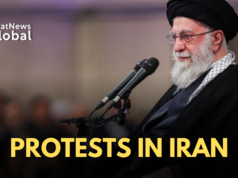The hardline policies of US President Donald Trump—influenced by ‘America First’ ideology—have intensified weaponisation of sweeping tariffs to achieve political aims.
Coupled with Trump’s inclination towards unilateral action over alignment with international organisations such as the UN and WTO, these policies risk instability and gradually erode the effectiveness of economic weapons altogether.
The U.S. bombing of Iran is a case in point. Amidst the Ukraine war and a brewing Sino-Russian relationship, using the Iran playbook against Russia could prove fatal for U.S. credibility.
Moreover, waging an economic war against an emerging economy and key partner—India—risks fragmenting the world trade order and damaging Washington’s reputation as its responsible custodian.
Trump’s Iran Policy
Reeling from the loss of credibility due to an unjust war in Iraq, the U.S. decided against military intervention in Iran. Instead, it turned to economic warfare through sanctions which, in 2015, led to the Joint Comprehensive Plan of Action (JCPOA) between Iran and P5+1 countries.
Iran agreed to constrain its nuclear programme in lieu of lifting of nuclear-related sanctions by the UN, the U.S. and its allies.
The economic war succeeded in achieving U.S. aims and, as Obama boasted, it did so “without firing a shot”. However, the U.S. did not achieve this goal alone. It required backing from its western allies and the broader international community through the UN. Essentially, it needed Iran’s total isolation from the global economy for the country to defer its nuclear ambitions.
Much of this success was undone by the first Trump administration, when the U.S. unilaterally withdrew from the JCPOA. Instead, it aimed at exerting ‘maximum pressure’ on Iran’s nuclear programme and reimposed all pre-2015 U.S. sanctions.
This policy eventually failed, without the support of UN and western allies, as it revitalised Iran’s nuclear ambitions. Additionally, it damaged U.S. credibility as meeting its demands was no longer viewed to be a trade-off for sanctions relief.
In June 2025, under Trump’s second administration, the U.S. bombed Iran’s nuclear sites in Fordow, Natanz and Isfahan as Tehran edged closer to weaponising its nuclear capabilities — an outcome the sanctions were designed to avoid.
Won’t Work Against Russia
Iran’s case proved that sanctions, when used as a means to an end with international backing, may achieve their ultimate goal. Whereas, when these weapons are overused with no endgame, their credibility and effectiveness deteriorate.
In Iran, a relatively smaller economy and not a nuclear-armed state, U.S. military force backed the non-compliance of US demands. Against Russia, a global heavyweight and nuclear-armed state, the Iran playbook is unlikely to work.
During Trump’s 2024 campaign trail, he pledged to stop the war in Ukraine within 24 hours of re-entering the White House. Seven months later, the bloodshed continues despite a barrage of sanctions targeted at Russia with support from U.S. allies.
While these sanctions have caused considerable damage to the Russian economy, Moscow understands that a ceasefire in Ukraine is not a guarantee for the sanctions to be lifted — as Iran proved.
In addition, due to Moscow’s possession of nuclear weapons, Washington will be unwilling to support its economic war with military threat — as it did in Iran.
Budding Sino-Russian Friendship
Another factor preventing Russia from changing course in Ukraine is its budding friendship with China.
Both countries are in the midst of an economic war against the United States. While Moscow is burdened with sanctions related to Ukraine, Beijing faces export controls and tariffs on U.S. exports critical to China’s emerging tech industry.
Unlike Iran, Russia is a major economic power with vast natural resources, large domestic market and deep economic ties with non-western economies such as China, India, Iran, etc.
While western nations cut their reliance on Russian energy exports, China has expanded its purchase by de-dollarising trade between the two countries to evade sanctions; made possible by Russia’s alternative to SWIFT payment system — SPFS.
In addition to deepening economic relations, Moscow and Beijing are also strengthening security ties. The two countries announced a new joint naval exercise in the Pacific region in late July. This marks the 114th combined drill between the two countries since 2003, over half of which occurred in the last six years.
A prolonged war in Ukraine, along with the overuse of U.S. economic weapons, will lead to a normalisation of these ties over time, with Russia and China developing alternatives to evade Western sanctions’ threat. In such a scenario, the U.S. economic weapons will no longer pose a credible threat to its geopolitical rivals.
Expanding U.S. Trade War With India
Trump has imposed 50% tariffs on India, partly as penalty for buying Russian oil. He also announced a trade deal with Pakistan.
By provoking a trade war with India, Trump has risked pushing a key defence and trade partner into a trading bloc with Russia, China and Iran — all member countries of BRICS. In such a case, a fragmentation of the world trade order between G7 and BRICS countries may happen, upending the gains of globalisation and U.S. credibility.
Alternatively, India may absorb the tariffs while continuing to deal with Washington, which will raise the cost of Indian exports to the U.S. and ultimately be paid by American consumers. This will add to domestic political pressure on Trump, who already faces backlash over rising costs. In either case, Trump’s trade war with India will cost the U.S. its reputation as a reliable partner.
(The author is a law and politics graduate from Cardiff University. Views expressed here are personal)





